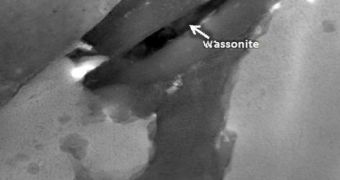While conducting a new investigation on a meteorite discovered decades ago, experts were able to identify that the structure contained a previously-unidentified type of mineral. Analysis has confirmed an extraterrestrial origin for the material.
The team was investigating an enstatite chondrite called Yamato 691, which was discovered in Antarctica some 42 years ago. The rock has been heavily studied since, but the new work used an advanced electron microscope to conduct its investigations.
They discovered a new mineral within, and named the material Wassonite. Investigations have revealed that the meteorite itself is more than 4.5 billion years old, which means that it has about the same age as our planet does.
Its chemical composition and structure appear to suggest that it originated in the Inner Asteroid Belt (IAB), a vast collection of meteorites and asteroids that lies between the orbits of Mars and Jupiter.
According to Keiko Nakamura-Messenger, the NASA investigator who conducted the new research, the crystal structure that the newly-found material has was never been observed before.
“Wassonite is a mineral formed from only two elements, sulfur and titanium, yet it possesses a unique crystal structure that has not been previously observed in nature,” the researcher says.
He adds that the mineral was named after University of California in Los Angeles (UCLA) meteorite researcher John T. Wasson, and that the material is now listed as approved on the official list of the International Mineralogical Association (IMA). The list contains around 4,500 entries.
It is estimated that the meteorite analyzed in the new study contains additional types of minerals as well. Researchers are currently hard at work in investigating a few leads they found while conducting their study on Wassonite.
The electron microscope revealed interesting structures next to the small deposit containing the new stuff, and investigators are currently focusing their attention on the other structures. The Wassonite deposit is about 50 by 450 nanometers wide.
“More secrets of the universe can be revealed from these specimens using 21st century nanotechnology,” Nakamura-Messenger explains, quoted by Universe Today.
“Meteorites, and the minerals within them, are windows to the formation of our solar system. Through these kinds of studies we can learn about the conditions that existed and the processes that were occurring then,” adds Lindsay Keller.
The expert holds an appointment as a space scientist at the NASA Johnson Space Center in Houston, Texas. Keller was the principal investigator of the new microscope study as well.

 14 DAY TRIAL //
14 DAY TRIAL //